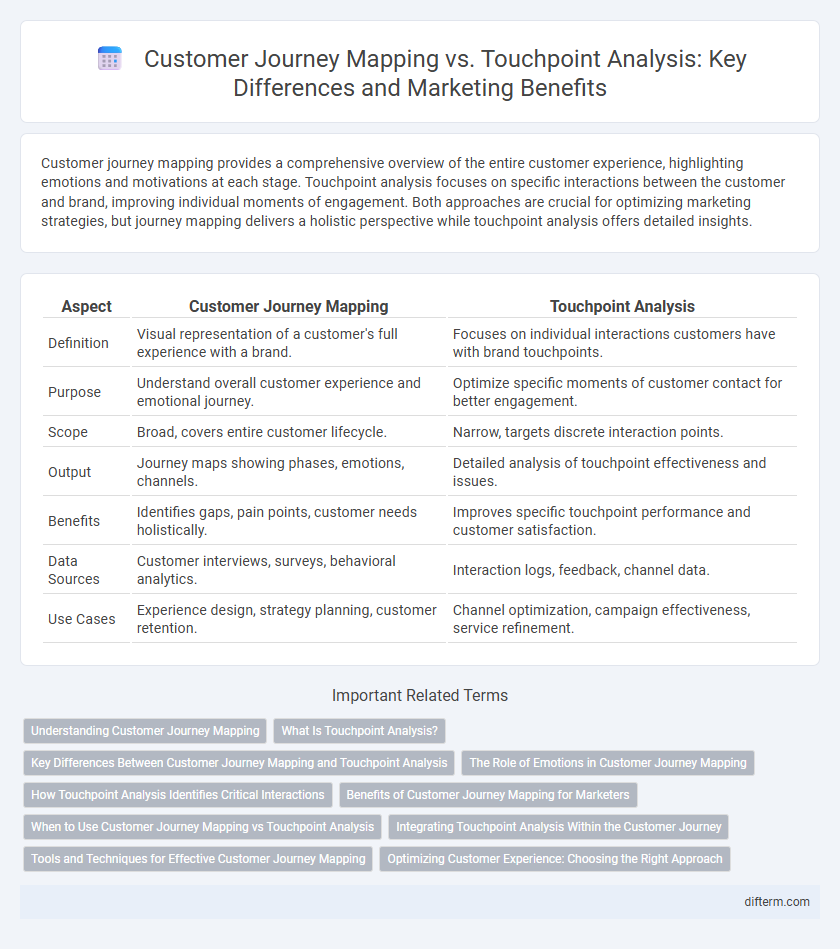Customer journey mapping provides a comprehensive overview of the entire customer experience, highlighting emotions and motivations at each stage. Touchpoint analysis focuses on specific interactions between the customer and brand, improving individual moments of engagement. Both approaches are crucial for optimizing marketing strategies, but journey mapping delivers a holistic perspective while touchpoint analysis offers detailed insights.
Table of Comparison
| Aspect | Customer Journey Mapping | Touchpoint Analysis |
|---|---|---|
| Definition | Visual representation of a customer's full experience with a brand. | Focuses on individual interactions customers have with brand touchpoints. |
| Purpose | Understand overall customer experience and emotional journey. | Optimize specific moments of customer contact for better engagement. |
| Scope | Broad, covers entire customer lifecycle. | Narrow, targets discrete interaction points. |
| Output | Journey maps showing phases, emotions, channels. | Detailed analysis of touchpoint effectiveness and issues. |
| Benefits | Identifies gaps, pain points, customer needs holistically. | Improves specific touchpoint performance and customer satisfaction. |
| Data Sources | Customer interviews, surveys, behavioral analytics. | Interaction logs, feedback, channel data. |
| Use Cases | Experience design, strategy planning, customer retention. | Channel optimization, campaign effectiveness, service refinement. |
Understanding Customer Journey Mapping
Customer journey mapping visualizes the entire experience a customer has with a brand, capturing emotions, motivations, and pain points across all interactions. It provides a holistic view of customer behavior and decision-making processes, enabling marketers to identify opportunities for enhancing satisfaction and loyalty. This strategic tool differs from touchpoint analysis, which focuses narrowly on individual interactions rather than the full customer lifecycle.
What Is Touchpoint Analysis?
Touchpoint analysis examines every interaction point a customer has with a brand to identify opportunities for improving customer experience and increasing engagement. It focuses on individual moments across channels such as website visits, social media interactions, and customer service contacts, measuring effectiveness and satisfaction at each stage. This data-driven approach helps marketers optimize resource allocation and tailor messaging to enhance overall brand loyalty.
Key Differences Between Customer Journey Mapping and Touchpoint Analysis
Customer journey mapping provides a comprehensive visualization of the entire customer experience across multiple channels and stages, highlighting emotions, motivations, and pain points over time. Touchpoint analysis focuses specifically on individual interactions between the customer and brand, evaluating the effectiveness and quality of each contact point. While journey mapping offers a strategic overview, touchpoint analysis delivers granular insights critical for optimizing specific moments in the customer lifecycle.
The Role of Emotions in Customer Journey Mapping
Emotions play a critical role in customer journey mapping by highlighting how feelings influence decision-making at each stage of the journey, providing deeper insights than touchpoint analysis alone. Customer journey mapping captures emotional highs and lows, enabling marketers to tailor experiences that foster loyalty and satisfaction. This emotional understanding drives targeted strategies that enhance engagement beyond the transactional focus of touchpoint analysis.
How Touchpoint Analysis Identifies Critical Interactions
Touchpoint analysis identifies critical interactions by examining each point where customers engage with a brand, revealing moments that significantly influence customer satisfaction and decision-making. It provides granular insights into customer behavior at specific contact points, enabling marketers to optimize experiences that drive conversions and loyalty. This targeted approach uncovers friction areas and opportunities for personalized engagement within the broader customer journey.
Benefits of Customer Journey Mapping for Marketers
Customer journey mapping enables marketers to visualize and understand the complete customer experience across all channels, revealing pain points and opportunities for engagement. This strategic tool improves customer targeting and personalization by tracking emotions and behaviors at each stage, leading to increased satisfaction and loyalty. By identifying critical moments in the buying process, marketers can optimize resource allocation, drive conversions, and enhance overall campaign effectiveness.
When to Use Customer Journey Mapping vs Touchpoint Analysis
Customer journey mapping is ideal for understanding the entire end-to-end experience a customer has with a brand, highlighting emotions and pain points across multiple stages. Touchpoint analysis is more effective when businesses need to evaluate and optimize individual interactions or channels within the broader customer journey. Use customer journey mapping for strategic improvements and touchpoint analysis for tactical enhancements.
Integrating Touchpoint Analysis Within the Customer Journey
Integrating touchpoint analysis within the customer journey enhances the understanding of each interaction's impact on customer experience and decision-making. By mapping detailed touchpoints across various stages--awareness, consideration, purchase, and post-purchase--marketers can identify pain points and optimize engagement strategies. This synergy drives targeted improvements, increases customer satisfaction, and boosts conversion rates.
Tools and Techniques for Effective Customer Journey Mapping
Effective customer journey mapping utilizes visual tools such as journey maps, personas, and experience diagrams that organize customer interactions across various touchpoints. Techniques like data analytics, heat maps, and sentiment analysis enrich the journey map by identifying pain points and emotional highs throughout the customer lifecycle. Leveraging software tools such as CX platforms and CRM integrations enables real-time tracking, personalized insights, and seamless collaboration among marketing teams.
Optimizing Customer Experience: Choosing the Right Approach
Customer journey mapping provides a holistic view of the entire customer lifecycle, identifying pain points and opportunities across multiple stages, while touchpoint analysis focuses on optimizing individual customer interactions. Selecting the right approach depends on the business objective: journey mapping suits strategic, end-to-end experience improvements, whereas touchpoint analysis targets tactical enhancements at specific moments. Integrating both methods drives comprehensive customer experience optimization and maximizes satisfaction and loyalty.
Customer journey mapping vs touchpoint analysis Infographic

 difterm.com
difterm.com